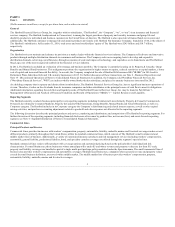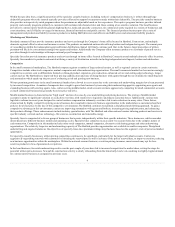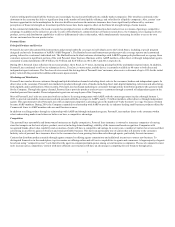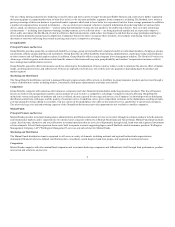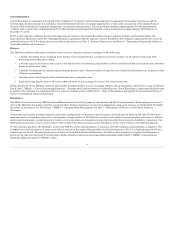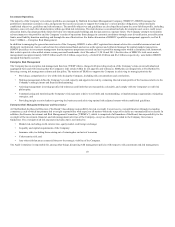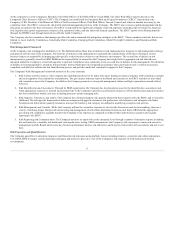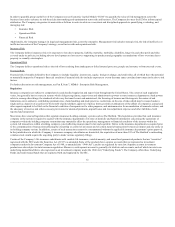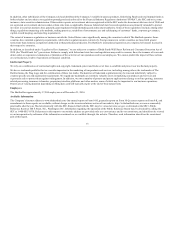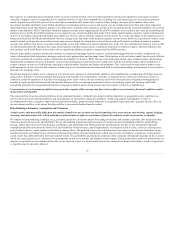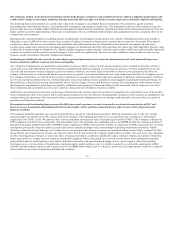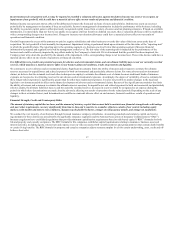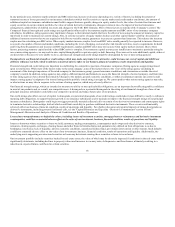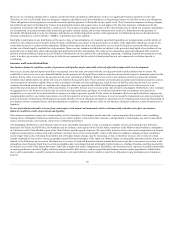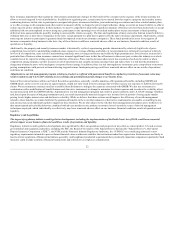The Hartford 2014 Annual Report Download - page 15
Download and view the complete annual report
Please find page 15 of the 2014 The Hartford annual report below. You can navigate through the pages in the report by either clicking on the pages listed below, or by using the keyword search tool below to find specific information within the annual report.
Our exposure to commodity prices primarily relates to our investment portfolio. Our investment portfolio includes fixed maturities and equity securities
issued by companies and sovereigns that derive a portion of their revenues from commodities, including oil, coal, natural gas, precious and non-precious
metals. In periods in which the prices of these and other commodities fall, absent other countervailing changes, decreases in the market value of our
investment portfolio will likely result. If these declines in commodities prices are severe and persist over an extended period of time, other-than-temporary
impairments may result. Our statutory surplus is also affected by widening credit spreads as a result of the accounting for the assets and liabilities on our fixed
market value adjusted (“MVA”) annuities. Statutory separate account assets supporting the fixed MVA annuities are recorded at fair value. In determining the
statutory reserve for the fixed MVA annuities we are required to use current crediting rates in the U.S. In many capital market scenarios, current crediting rates
in the U.S. are highly correlated with market rates implicit in the fair value of statutory separate account assets. As a result, the change in the statutory reserve
from period to period will likely substantially offset the change in the fair value of the statutory separate account assets. However, in periods of volatile credit
markets, actual credit spreads on investment assets may increase sharply for certain sub-sectors of the overall credit market, resulting in statutory separate
account asset market value losses. As actual credit spreads are not fully reflected in current crediting rates in the U.S., the calculation of statutory reserves will
not substantially offset the change in fair value of the statutory separate account assets, resulting in reductions in statutory surplus. This has resulted in the
past and may result in the future in the need to devote significant additional capital to support the fixed MVA product.
Our real estate market exposure includes investments in commercial mortgage-backed securities, residential mortgage-backed securities, commercial real
estate collateralized debt obligations, mortgage and real estate partnerships, and mortgage loans. Deterioration in the real estate market has adversely affected
our business, financial condition, results of operations and liquidity in the past. While the real estate market has shown signs of improvement, deteriorating
fundamentals (including increases in property vacancy rates, delinquencies and foreclosures) could cause a decline in market values, which would have a
negative impact on sources of refinancing, resulting in reduced market liquidity and higher risk premiums. This could result in reductions in market value
and impairments of real estate-backed securities, a reduction in net investment income associated with real estate partnerships, and increases in our valuation
allowance for mortgage loans.
Significant declines in equity prices, changes in U.S. interest rates, changes in credit spreads, inflation, the strengthening or weakening of foreign currencies
against the U.S. dollar or real estate market deterioration, individually or in combination, could have a material adverse effect on our business, financial
condition, results of operations or liquidity. Our hedging assets seek to reduce the net economic sensitivity of our potential obligations from guaranteed
benefits to equity market and interest rate fluctuations. Because of the accounting asymmetries between our hedging targets and statutory and GAAP
accounting principles for our guaranteed benefits, rising equity markets and/or rising interest rates may result in statutory or GAAP losses.
Concentration of our investment portfolio in any particular segment of the economy may have adverse effects on our business, financial condition, results
of operations and liquidity
The concentration of our investment portfolios in any particular industry, collateral type, group of related industries or geographic sector could have an
adverse effect on our investment portfolios and consequently on our business, financial condition, results of operations and liquidity. Events or
developments that have a negative impact on any particular industry, group of related industries or geographic region may have a greater adverse effect on
our investment portfolio to the extent that the portfolio is concentrated rather than diversified.
Actual results could materially differ from the analytical models we use to assist our decision making in key areas such as underwriting, capital, hedging,
reserving, and catastrophe risks, which could have a material adverse effect on our business, financial condition, results of operations or liquidity.
We employ various modeling techniques (e.g., scenarios, predictive, stochastic and/or forecasting) to analyze and estimate exposures, loss trends and other
risks associated with our assets and liabilities. We use the modeled outputs and related analyses to assist us in decision-making related to underwriting,
pricing, capital allocation, reserving, hedging, reinsurance, and catastrophe risk. Both proprietary and third party models we use incorporate numerous
assumptions and forecasts about the future level and variability of interest rates, capital requirements, loss frequency and severity, currency exchange rates,
policyholder behavior, equity markets and inflation, among others. The modeled outputs and related analyses are subject to the inherent limitations of any
statistical analysis, including the use of historical internal and industry data and assumptions, which may be stale, incomplete or erroneous. Consequently,
actual results may differ materially from our modeled results. The profitability and financial condition of the Company substantially depends on the extent to
which our actual experience is consistent with assumptions we use in our models and ultimate model outputs. If, based upon these models or other factors, we
misprice our products or our estimates of the risks we are exposed to prove to be materially inaccurate, our business, financial condition, results of operations
or liquidity may be adversely affected.
15


